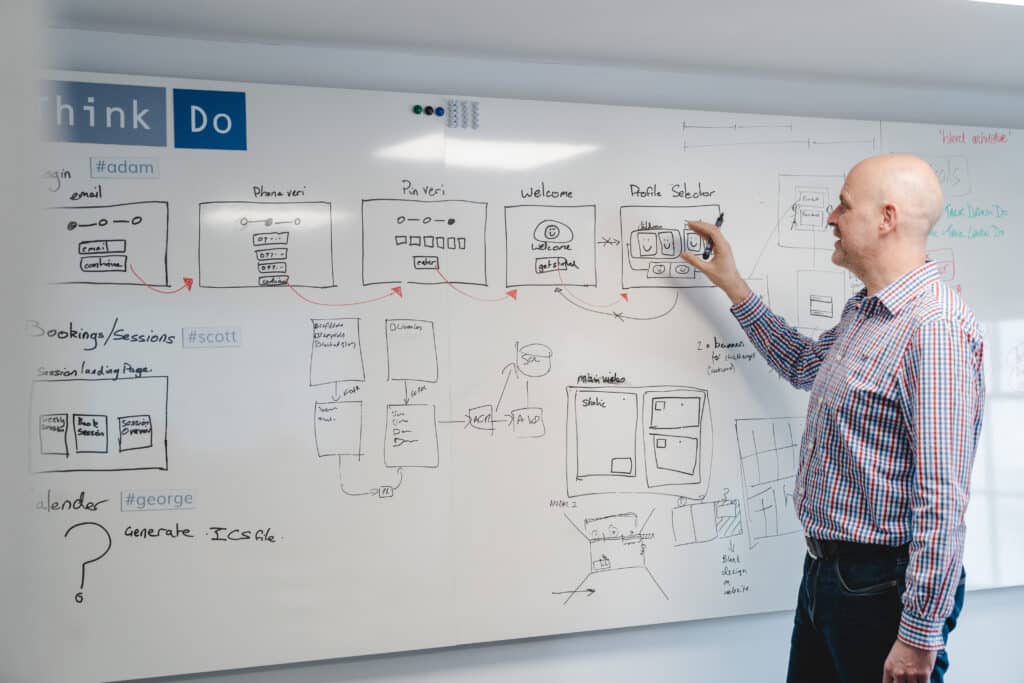Why the Cloud Development Discovery Phase Can Make or Break Your Project

The discovery phase – learning about and analysing the problem/task/project at hand – is always crucial to achieving the right solution in any endeavour. And this is certainly true when building or migrating software into Microsoft Azure. That’s why we’ve created this article: to explore what makes an effective cloud development discovery phase when preparing a customer-facing app through Microsoft’s cloud computing service.
Ok, so what is the cloud development discovery phase?
In cloud development terms, the discovery phase of a project is where you define the functionality required and the architecture needed to support it, as well as working out the projected costs and resources needed to deliver your solution. But that’s a broad description – when you drill down, there’s a lot more to it.
When building cloud software, discovery can involve a team including:
- Business analysts to assess requirements from a business point of view
- Developers to input on the build, technical requirements, timeframe, etc.
- User experience (UX) experts to ensure the solution is as intuitive as possible
- Solution architects to look at environment and performance/scalability/maintenance
- Project managers to coordinate and document this phase (and future stages)
That may seem like a lot of people to have on board, but all of them handle vital considerations that must be addressed to deliver a solution that’s on time, on budget, fit for purpose and won’t cause problems further down the road.
That’s why trying to ‘wing it’ is unlikely to work – illustrated by a recent survey from Nielsen Norman Group (NN/g). The research and consulting firm found that 83% of projects with discovery phases were reported as successes as opposed to only 52% of projects without. So, you could forgo this phase. But be warned that it really does reduce your chances of success.
Now that we’ve established the ‘what’ and ‘why’, let’s look at the ‘how’.
In-house or outsource?
Many organisations either don’t have the necessary skillsets within their ranks or the resources available to conduct a thorough, successful discovery phase of a project on their own. They may have project managers on board, but those PMs might not be experienced in technology projects. Or their technology personnel may extend to an IT department tasked with ‘keeping the lights on’ but not developers ready to rearchitect an on-premises application in the cloud. That’s why these organisations enlist third parties to help with the cloud development discovery phase and beyond.
However, outsourcing development also brings its own concerns to the table. You need to be sure that the third-party you bring in will do a thorough job of discovery but won’t mire you in an unnecessarily protracted, resource-and-time-intensive phase that means you’re haemorrhaging cash.
Discovery vs. rummaging around in the dark
Here’s an analogy. One day, a mystery electrical fault causes a blackout in your home. You call an electrician to solve the problem. They tinker about trying to figure out the source of the issue, but they aren’t familiar with how your home is wired up and what’s located where, so they cut holes in walls and rummage around for hours before they discover the solution. And they’ve been on the clock, with the bill rising and rising, and you without electricity, all that time.
Alternatively, you could choose an electrician who has worked on homes like yours before – perhaps in the same apartment building or row of houses – and has a good idea of the likely wiring and layout. They’ve seen this problem before, and they know exactly how best to fix it – in the right way, with the right materials, and without spending more time than is necessary.
Picking the right people for the job
Choosing the right partner for discovery and the rest of your cloud project is the same as my analogy. Pick someone unfamiliar with projects like yours – for instance, a larger corporate Jack-of-all-trades-but-master-of-none – and you could find yourself metaphorically peering at your watch while they come to conclusions others might have reached long ago. And in doing so, they may also have diverted the attentions of your people and your resources away from valuable work, unnecessarily.
However, if their approach to discovery is a little too short, or they just take a long time to reach the wrong conclusions, you could end up running into problems later in the development process, or when your solution is up and running. There’s also the danger of wasting time and money on solutions that go far beyond what you actually need – what we sometimes call ‘technology for the sake of it’. All in all, there’s a lot of potential for spiralling costs that could have been avoided.
Talking, thinking and doing
At Talk Think Do, we understand the importance of doing discovery right. It’s something we’ve learned from delivering a wide range of tech projects over the years. We know how to get straight to your fundamental business objectives via a short, expert consultation. Once we’ve quickly developed that understanding, we can then discern what the right solution is for you – and we bring together all the talent you need to build your solution quickly, efficiently, and completely in line with your needs and budget.
That’s the true value of including a discovery phase – and making it count.
If you want to start building cloud software or embark on any other technology project, and you want to make sure you get it right (not to mention on time and on budget), get in touch with Talk Think Do today.
Get access to our monthly
roundup of news and insights
You can unsubscribe from these communications at any time. For more information on how to unsubscribe, our privacy practices, and how we are committed to protecting and respecting your privacy, please review our Privacy Policy.
See our Latest Insights
Working as One Team: How Our Business Analysts Bridge Vision and Delivery
When clients partner with us, they often expect engineers and designers. But one of the most powerful roles behind a successful digital product is often less visible: the Business Analyst (BA). At Talk Think Do, BAs aren’t just requirement-gatherers. We’re connectors, between vision and execution, users and features, partners and platforms. In the recent delivery…
Implementing RAG AI Search on On-Premise Files with our AI Search Accelerator
As demand for AI‑powered tools like Microsoft Copilot grows, many organisations are asking the same question: “How can we harness the power of generative AI without moving our sensitive data to the cloud?” In this guide, we’ll explain why Retrieval‑Augmented Generation (RAG) is so effective for on‑premise data and walk through a practical approach using…
Using AI to Strengthen ISO 27001 Compliance
Preparing for our ISO 27001:2022 recertification, and a transition from the 2013 standard, was no small task. As a custom software company handling sensitive client data, we hold ourselves to high standards around security and compliance. But this year, we approached the challenge differently. We built and deployed a custom AI Copilot agent to help…
Legacy systems are costing your business growth.
Get your free guide to adopting cloud software to drive business growth.





